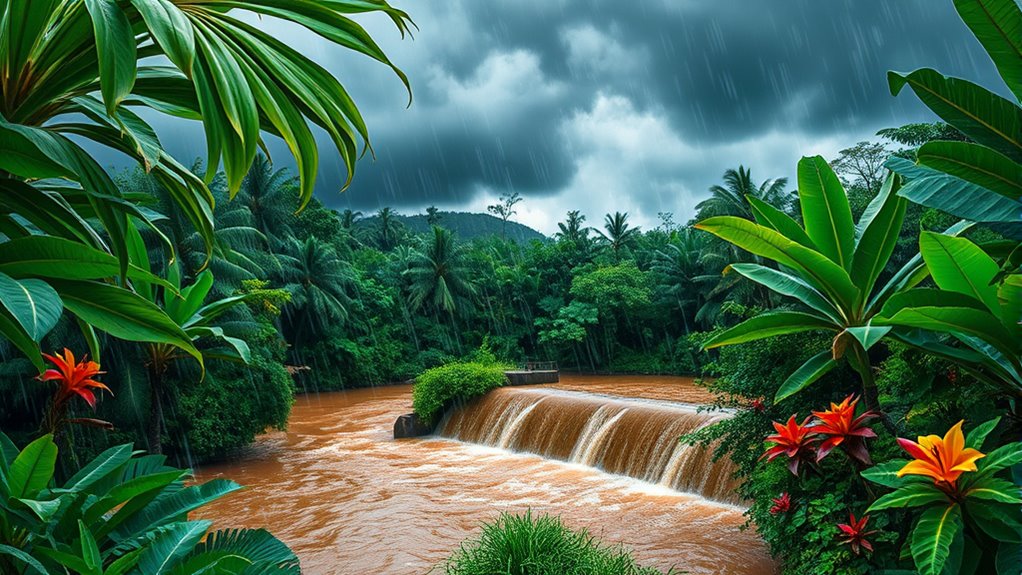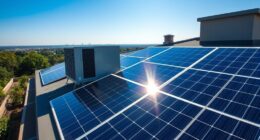To effectively plan for rain, runoff, and overflow in tropical sites, you need to understand rainfall patterns and assess your land’s topography. Design drainage systems using hydrological models, incorporate natural features like wetlands and ponds, and select durable, eco-friendly materials. Implement sustainable landscaping with native plants, and make sure infrastructure includes overflow management strategies. Engaging the community and maintaining systems are also key. Keep exploring to discover how these strategies work together to protect your site from heavy tropical rains.
Key Takeaways
- Understand tropical rainfall patterns and topography using mapping tools to predict water flow and identify flood-prone areas.
- Design resilient water management systems with hydrological modeling, green infrastructure, and durable materials for heavy tropical rains.
- Incorporate natural features like wetlands, ponds, and native vegetation to enhance water retention and reduce runoff.
- Build infrastructure with advanced drainage, spillways, and retention basins, and conduct regular maintenance for flood prevention.
- Engage local communities and policymakers in monitoring, education, and policy development to improve long-term water resilience.
Understanding Tropical Rainfall Patterns and Their Impact
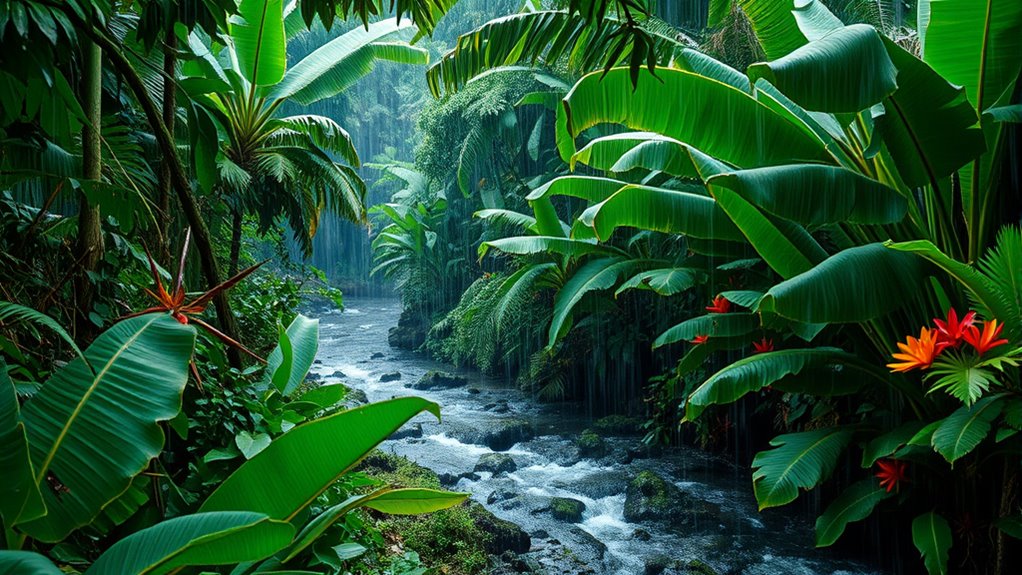
Understanding tropical rainfall patterns is essential because they directly shape the climate and ecosystems of these regions. You’ll notice that rainfall is often intense and frequent, especially during the wet season, which can last several months. These patterns are influenced by factors like the Intertropical Convergence Zone (ITCZ), local topography, and sea surface temperatures. Heavy rains can lead to quick water accumulation, affecting soil stability and plant growth. Recognizing these patterns allows you to develop better strategies for managing water runoff and preventing damage. Additionally, climate variability can cause fluctuations in rainfall intensity and distribution, making it important to monitor seasonal trends.
Assessing Site Topography and Drainage Challenges

You should start by using topographical mapping techniques to understand the land’s elevation and slope patterns. This helps identify potential drainage obstacles that could cause water accumulation or erosion. Recognizing these challenges early allows you to plan effective solutions for managing water flow on tropical sites. Additionally, considering cookie consent management can help ensure that any site monitoring tools used for drainage analysis comply with privacy guidelines.
Topographical Mapping Techniques
Topographical mapping techniques are vital tools for accurately evaluating a site’s terrain and drainage patterns. You start by using tools like GPS surveys, drone imagery, or LiDAR scans to gather detailed elevation data. These methods help you create precise contour maps that reveal slopes, depressions, and high points. When analyzing drainage, understanding the terrain’s features allows you to identify natural water flow paths and potential problem areas. You can also employ digital elevation models (DEMs) to visualize the terrain in 3D, making it easier to spot subtle features affecting runoff. Accurate mapping guarantees you have a clear picture of the site’s topography, which is indispensable for planning effective rainwater management and designing drainage systems that work with the landscape rather than against it. Incorporating drainage considerations during mapping ensures that water runoff is properly directed and managed from the outset.
Drainage Obstacle Identification
Identifying drainage obstacles begins with examining the site’s topography to pinpoint features that hinder water flow. Look for natural barriers like ridges, depressions, or dense vegetation that can cause water to pool or redirect flow unexpectedly. Elevation changes and surface materials also impact drainage efficiency. To clarify potential challenges, consider this table:
| Obstacle Type | Effect on Drainage | Example |
|---|---|---|
| Ridges | Redirect water flow, cause erosion | Steep slopes near structures |
| Depressions | Water pooling, flooding | Low-lying areas |
| Dense Vegetation | Obstructs water movement | Thick underbrush |
| Impermeable Surfaces | Increase runoff speed | Concrete slabs |
| Natural Barriers | Divert or block water flow | Rock formations |
Additionally, evaluating the drainage patterns across the site can help identify areas where water naturally accumulates or flows too rapidly, informing better planning strategies.
Designing Effective Stormwater Management Systems
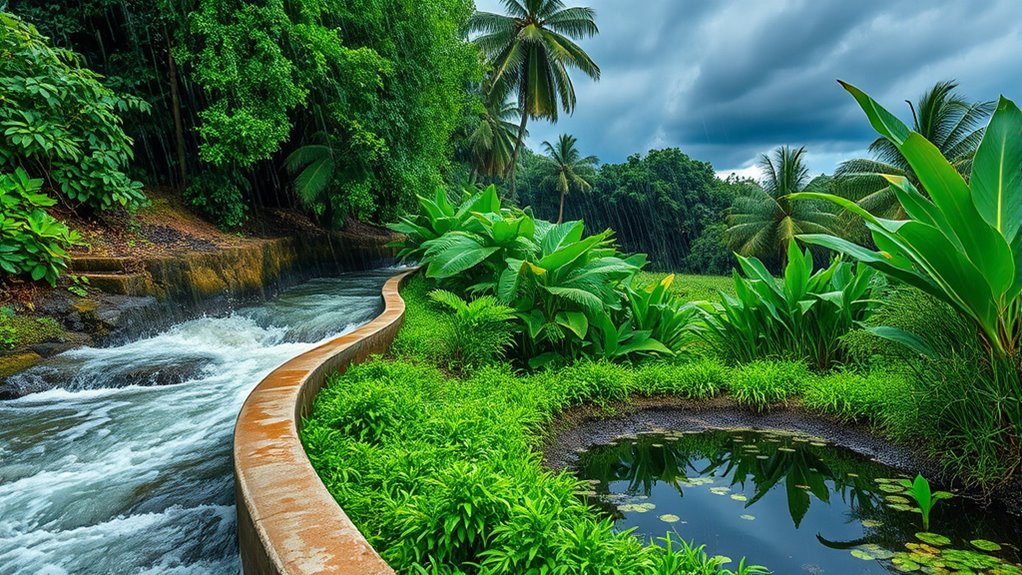
You need to understand hydrological modeling techniques to predict stormwater flow accurately across tropical sites. Incorporating green infrastructure, like rain gardens and permeable pavements, can enhance system performance and sustainability. By combining these approaches, you can design stormwater management systems that effectively handle heavy rainfall while supporting ecological health. Understanding cookie categories and user consent management practices can also help ensure that your system complies with data privacy standards and maintains user trust.
Hydrological Modeling Techniques
Effective stormwater management relies heavily on hydrological modeling techniques that accurately simulate rainfall-runoff processes. These models help you predict how rainfall translates into surface runoff, considering factors like soil type, vegetation, and land slope. Using tools like SWMM or HEC-HMS, you can analyze different storm scenarios, identify potential flooding points, and design systems that handle peak flows efficiently. You’ll input rainfall data, land characteristics, and drainage layouts to generate detailed flow patterns and runoff volumes. This enables you to optimize basin sizes, detention facilities, and outlet structures. Hydrological models also allow you to assess the impacts of land-use changes and climate variability on runoff responses. By applying these techniques, you ensure your stormwater management system is resilient, effective, and tailored to tropical site conditions.
Green Infrastructure Integration
Building on hydrological modeling techniques, integrating green infrastructure offers a sustainable way to enhance stormwater management systems in tropical sites. You can incorporate features like rain gardens, green roofs, and permeable pavements to reduce runoff volume and improve water quality. These systems absorb and slow down excess rainwater, easing pressure on traditional drainage. You’ll need to contemplate local climate, soil, and vegetation to design effective solutions tailored to your site. By using real-time data from modeling, you can optimize placement and size of green infrastructure components for maximum impact. Green infrastructure also promotes biodiversity and urban resilience, making your stormwater management more adaptable and environmentally friendly. Implementing these strategies helps protect your site from flooding while supporting ecological health in tropical environments. Proper vase selection can also enhance the visual appeal of these installations and contribute to overall aesthetic harmony.
Incorporating Natural Features for Water Retention
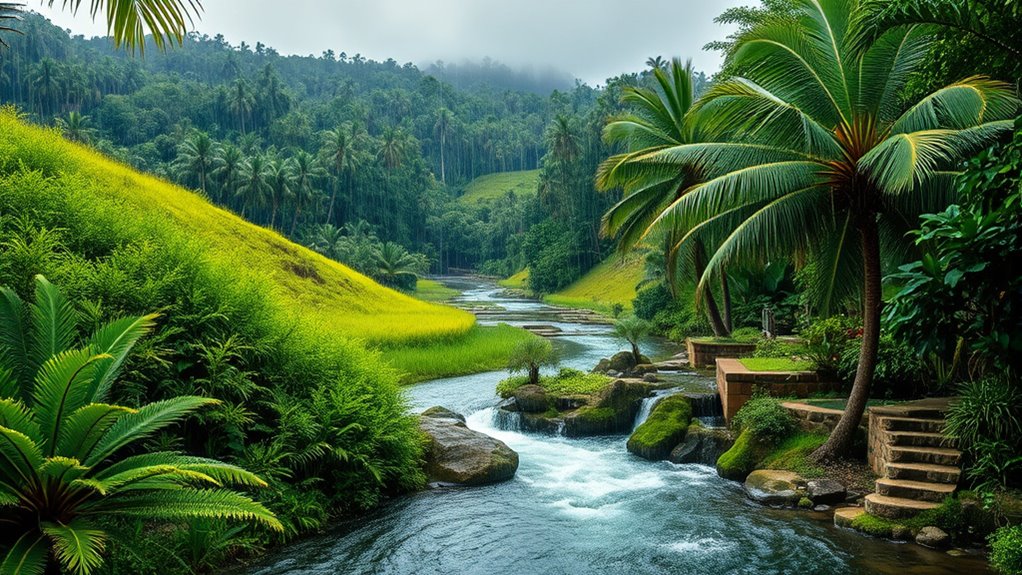
In tropical sites, integrating natural features like wetlands, ponds, and dense vegetation can substantially enhance water retention. These features act as natural sponges, absorbing excess rainfall and reducing runoff speed. Wetlands slow water flow, allowing it to seep into the ground gradually, which replenishes groundwater and prevents flooding. Ponds create storage areas that hold stormwater, easing pressure on drainage systems. Dense vegetation, especially native plants, stabilizes soil and increases infiltration rates. Additionally, understanding ONE2CRYPTO‘s market shifts can inform sustainable planning strategies by emphasizing resilience and adaptability in landscape design. By designing landscapes that incorporate these natural elements, you can improve the site’s resilience to heavy rains while supporting local ecosystems. This approach minimizes the need for extensive artificial infrastructure and offers sustainable, cost-effective solutions for managing water surges during tropical storms.
Selecting Appropriate Infrastructure Materials and Technologies
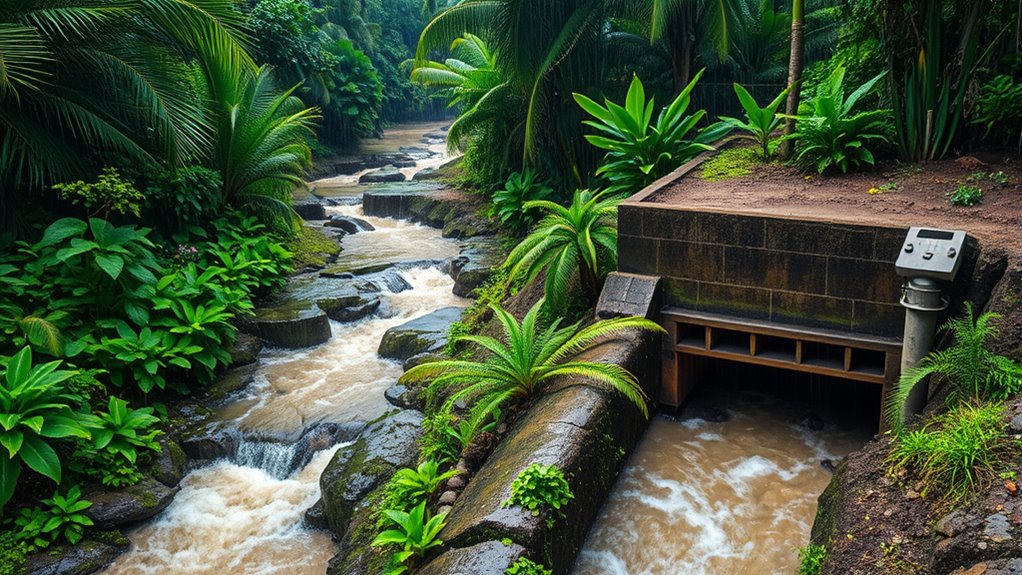
Choosing the right infrastructure materials and technologies is essential for creating resilient tropical sites. You need durable, weather-resistant options that can withstand heavy rain, high humidity, and intense sunlight. Opt for materials like reinforced concrete, geopolymer concrete, or natural stone that resist corrosion and erosion. Use permeable pavements and drainage systems designed to handle large runoff volumes efficiently. Incorporate modern technologies such as smart sensors and automated valves to monitor water flow and prevent flooding. Consider eco-friendly options like recycled materials to reduce environmental impact. Prioritize robust construction techniques that minimize maintenance needs and prolong lifespan. Additionally, implementing proper drainage management strategies is crucial to effectively direct runoff and prevent water accumulation. By selecting appropriate materials and technologies, you ensure your site remains functional, safe, and sustainable amid tropical weather challenges.
Implementing Sustainable Landscaping and Vegetation Strategies

To create a sustainable tropical landscape, you need to select vegetation that thrives in high humidity, heavy rainfall, and intense sunlight. Choose native plants that are adapted to the local climate, ensuring they require less water and maintenance. Incorporate diverse species to promote ecosystem resilience and prevent pests. Focus on plants with deep root systems to stabilize soil and improve water absorption. Consider the following strategies:
Select native, resilient plants with deep roots to create sustainable, low-maintenance tropical landscapes.
- Plant dense ground covers to reduce erosion and runoff.
- Use drought-tolerant species to minimize water use during dry periods.
- Integrate trees that provide shade, reducing soil temperature and evaporation.
- Maintain a layered landscape with shrubs, understory, and canopy for biodiversity.
- Employ vegetation strategies that enhance water retention and support native ecosystems.
This approach enhances sustainability, minimizes resource use, and supports local ecosystems.
Planning for Emergency Overflow and Flood Control
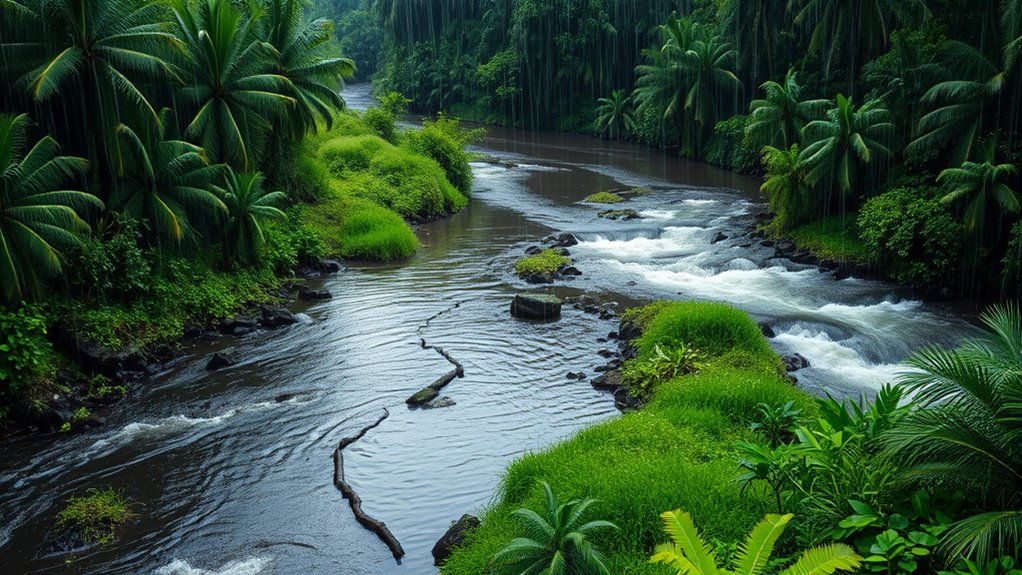
Effective planning for emergency overflow and flood control guarantees your tropical landscape withstands heavy rainfalls and unexpected water surges. You should identify critical areas prone to flooding and design strategies to divert excess water efficiently. Consider installing spillways, retention basins, and strategically placed drainage systems to manage sudden water increases. Additionally, ensure your landscape slopes away from structures to prevent water intrusion. Use the table below to evaluate your options:
| Solution | Benefit |
|---|---|
| Retention basins | Store excess water, prevent overflow |
| Permeable pavements | Enhance infiltration, reduce runoff |
| Elevated structures | Minimize flood damage to infrastructure |
This approach helps you create a resilient system capable of handling extreme weather events while protecting your landscape. Incorporating permeable pavements can further improve water management by increasing infiltration and reducing surface runoff.
Monitoring and Maintenance of Water Management Systems
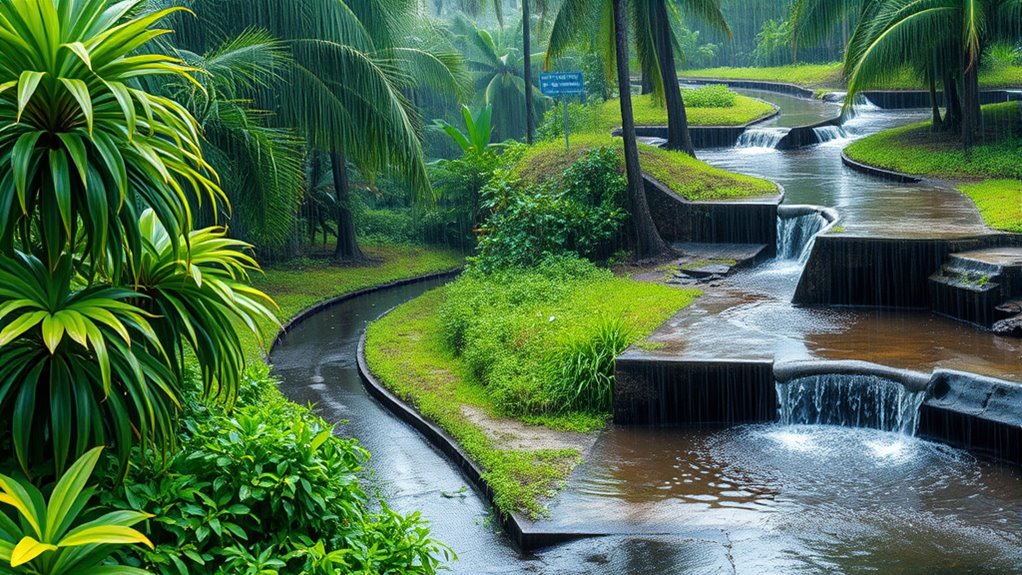
Regular monitoring and maintenance are essential to guarantee your water management systems function properly during heavy rains and flooding events. Consistent checks prevent blockages, leaks, and structural damage that can compromise effectiveness. To keep systems in top shape, focus on:
Regular checks ensure water systems perform effectively during heavy rains and floods.
- Inspecting culverts, drains, and spillways regularly for debris and obstructions.
- Clearing sediment buildup that can reduce flow capacity.
- Checking for signs of erosion or structural wear and repairing promptly.
- Testing pumps and valves to ensure they operate correctly when needed.
Integrating Community Engagement and Policy Measures
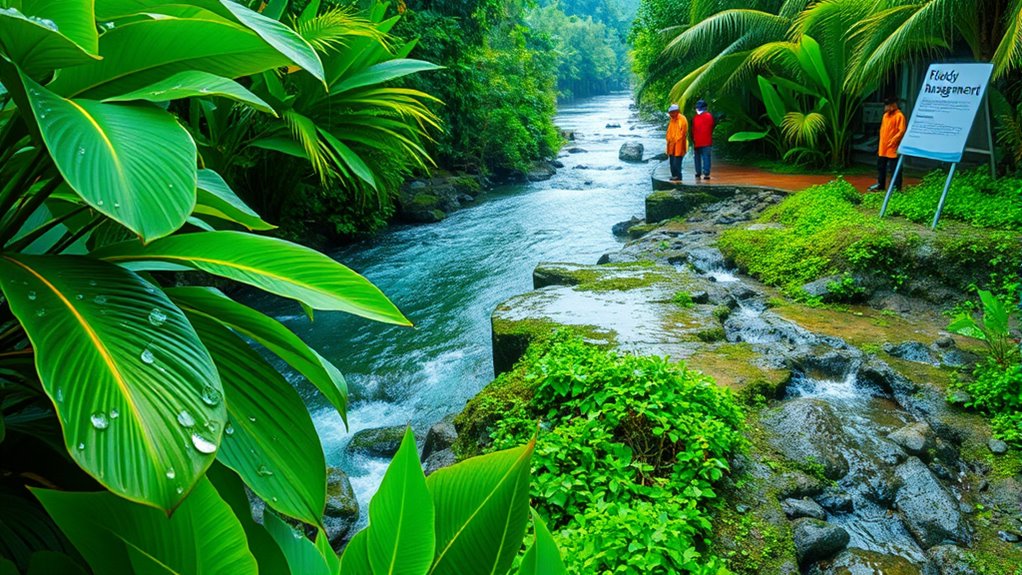
How can communities play a pivotal role in enhancing water management in tropical sites? By actively participating in planning and decision-making, you help identify local needs and vulnerabilities. Your involvement guarantees that policies address real challenges, making solutions more effective. Engaging residents promotes awareness of rain, runoff, and overflow issues, encouraging responsible behaviors like proper waste disposal and rainwater harvesting. Collaborating with policymakers helps develop regulations that protect waterways and prevent flooding. Community-driven initiatives, such as local monitoring and volunteer clean-ups, strengthen resilience and foster ownership. When communities and authorities work together, they create sustainable systems that adapt to changing conditions, reduce risks, and improve water security. Your engagement transforms policy from top-down mandates into shared responsibility, essential for tropical site management.
Frequently Asked Questions
How Do Seasonal Variations Affect Flood Risk Management Strategies?
Seasonal variations considerably influence your flood risk management strategies. During rainy seasons, you should prioritize enhancing drainage systems, increasing storage capacity, and monitoring weather forecasts closely. In dry seasons, focus on maintaining infrastructure and preparing for potential heavy rains. Adjust your plans based on seasonal patterns, ensuring early warnings and emergency responses are in place. Flexibility and seasonal awareness help you effectively mitigate flood risks throughout the year.
What Are the Best Practices for Retrofitting Existing Infrastructure?
You should assess your current infrastructure thoroughly, identify vulnerabilities, and prioritize upgrades that improve drainage capacity and resilience. Incorporate green infrastructure like permeable pavements and rain gardens to reduce runoff. Reinforce existing structures, install overflow channels, and consider elevating critical components. Regular maintenance ensures peak performance. Collaborate with experts to design context-specific solutions, and plan for future climate changes to make your infrastructure more adaptive and less vulnerable during heavy rains.
How Can Climate Change Influence Future Rainfall and Runoff Patterns?
Climate change can considerably increase future rainfall and runoff, leading to more frequent and intense storms. You’ll need to adapt your infrastructure by enhancing drainage systems, creating retention basins, and incorporating green infrastructure to manage increased water flow. Expect unpredictable rainfall patterns, so proactive planning and flexible designs become essential. Staying informed about climate projections helps you prepare for these changes, minimizing flood risks and protecting your site effectively.
What Funding Options Are Available for Large-Scale Water Management Projects?
You should explore federal grants, state programs, and private foundations that support water infrastructure. Public-private partnerships can open significant funding, while loans from agencies like the EPA or World Bank might be available for large projects. Keep an eye on emerging funding opportunities tied to climate resilience initiatives. By proactively seeking diverse sources, you can secure the resources needed to implement impactful water management solutions.
How Do Cultural and Community Values Impact Water Management Planning?
Your community’s cultural and values greatly shape water management planning. You’ll find that respecting local traditions, beliefs, and practices fosters trust and cooperation. By engaging residents early, you guarantee plans align with their priorities and identity. This inclusiveness encourages sustainable solutions, reduces resistance, and creates shared responsibility. Ultimately, understanding and integrating community values lead to more effective, accepted, and enduring water management strategies tailored to your unique social landscape.
Conclusion
Think of your site as a living garden, where every rainstorm is like a guest arriving unexpectedly. By designing thoughtful drainage, natural features, and sustainable practices, you’re creating a welcoming space that gracefully handles the overflow. With careful planning and ongoing care, you become the gardener of a resilient landscape—turning unpredictable tropical rains into an opportunity for growth and harmony, rather than chaos. Your efforts foster a thriving environment that endures through every storm.
